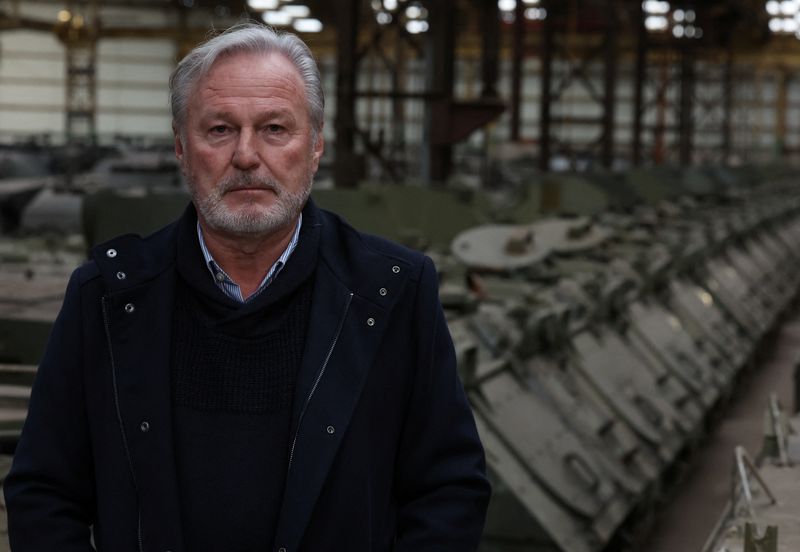By Andrew Gray
TOURNAI, Belgium (Reuters) - Freddy Versluys does not like to be called an arms dealer. But he does have a big warehouse full of second-hand tanks for sale.
Standing next to dozens of German-made Leopard 1 tanks and other military vehicles in the chilly warehouse in eastern Belgium, Versluys stressed he is the CEO of two defence companies with a broad range of activities, such as making sensors for spacecraft.
But buying and selling weapons is part of his business too. And it’s the tanks that have brought him into the spotlight over the past few days, as he has engaged in a public battle with Belgian Defence Minister Ludivine Dedonder over the possibility of sending them to Ukraine.
While other Western nations have pledged in recent weeks to send main battle tanks to help Ukraine repel Russia’s invasion, Belgium has not joined that group, for one reason above all: It doesn’t have any tanks left. It sold the last of them – a batch of 50 – to Versluys’s company more than five years ago.
Asked why he bought the tanks, Versluys, a silver-haired man in his mid-60s, said that was his company’s business model – it bought unwanted military equipment in the hope that someone else would want it in future.
“There are still countries in the world who have these Leopard 1 tanks. So there's always a possibility either to sell spare parts or to sell additional tanks,” he said.
But, he added: “Of course, it's a gamble... Maybe tomorrow we will have to scrap them (or) 10 years later they can still be there.”
Dedonder has said the government has explored the idea of buying back tanks to send them to Ukraine. But she has blasted the prices quoted as “unreasonable” and “extremely high”. Tanks sold for 10-15,000 euros each are being offered for sale at 500,000 euros, despite not being operational, she has said.
The spat highlights a predicament faced by Western governments as they scramble to find more weapons for Ukraine after almost a year of intense warfare – arms they discarded as obsolete are now in high demand, and many are now in the hands of private companies.
Dedonder hasn’t named Versluys’s company, OIP Land Systems, in her accusations. But Versluys is sure he is her target. Dedonder declined a request for an interview.
Versluys has taken the unusual step of going public to dispute the minister’s assertions, offering a rare insight into the workings of a business that often prefers to keep a low profile.
Versluys said his firm bought the 50 tanks for about 2 million euros and only 33 were useable. That would mean a unit price of 40,000 euros for 50 tanks, or some 60,600 euros for 33.
He said his selling price could range anywhere from several hundred thousand to close to a million euros but that would include work to refit the tanks, which he insisted could be highly expensive.
Replacing the system that controls the gunfire could cost 350,000 euros per tank, replacing asbestos in the engine could cost 75,000 euros, he said. Each tank had to be assessed individually.
“We still have to look at what is their actual status and what we have to spend on them to make them suitable,” he said.
MILITARY HYPERMARKET
As part of his public offensive, Versluys has given journalists tours of his warehouse on the outskirts of the provincial town of Tournai. It resembles a military hypermarket, filled with lines of Leopard 1 tanks in dusty green and black camouflage and scores of other military vehicles, along with shelves stacked with spare parts and piles of webbing.
In his sales pitch, Versluys also emphasises that refitted Leopard 1 tanks could be battlefield-ready in months - much more quickly than new models ordered today, which will take years to produce.
The Leopard 1 is the predecessor of the Leopard 2 tanks that Germany, Poland, Finland and other countries agreed last month to send to Ukraine. It is lighter than the Leopard 2 and has a different type of main gun. The models in Versluys’s warehouse were last upgraded in the 1990s.
Yohann Michel, an analyst at the International Institute for Strategic Studies think tank, said Leopard 1 tanks would not be as valuable on the battlefield as their successors.
But, he said, they could still be of some use in taking on older Russian tanks and in supporting infantry units, particularly if they were refitted to a high standard.
If Belgium does not buy back the tanks, another country could purchase them for Kyiv. Versluys said he had held discussions with several European governments about that option.
Last year, Britain bought 46 infantry fighting vehicles from his firm for Ukraine and sent out engineers who worked round the clock to refit them, Versluys said.
However, any export of Leopard 1s would require the approval from the Belgian region of Wallonia, where the company is based, and from Berlin, as the tanks were made by German firm KMW.

Versluys is a smooth salesman, reeling off names, model numbers and prices of numerous bits of military kit. He worked as an engineer in the Belgian military before going into business.
While he does not like the “arms dealer” label, he said the weapons business is better than its reputation: “Contrary to what people say, it’s quite a civilised market.”